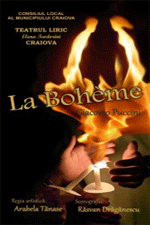> [Archived] Chronicles

La Boheme has returned to Craiova
An ending is a beginning... of a fairytale
I watched, on October 20th, the new mise en scène of the Puccinian creation, this time under the direction of Arabela Tanase and scenography by Rasvan Draganescu on traditional coordinates, but also bringing a new, inspired element - a giant 'book' in the far ground of the stage, whose pages were turned from one act to the other - but which, surprisingly enough, instead of closing in accordance with the last page, suggesting the end of the story or maybe even of the heroine (Mimì), returns to the front cover, as if starting over. On the other hand, the time appropriate design of the book, with buildings, streets and even a marching band, fades and doubles somehow the painted images in the background, also with houses and the bustle of the street, thus drowning it, instead of projecting it on a dark background which would clearly point out its significance and the respective scenes. And among the 19thcentury costumes, well designed, there's a modern pullover, worn by Marcello (act three) or a red T-shirt, with 'undefined' pictures, but still modern, which Rodolfo wears in act four, contrasting sharply with the tragic atmosphere, especially since he is at his lover's death bed.
As far as the direction is concerned, it follows the classic pattern, but the characters are pretty conventional and without the vivaciousness, humour and youthful explosion of the students in the Latin Quarter, even Musetta is too balanced, a far cry from the lively coquette that Henri Murger and Puccini envisioned, as a pair for the delicate Mimì. That is why, not even the two roles of composition - Benoît (Toni Zaharia) and Alcindoro (Gabriel Marciu) -generate any humour, they remain quite 'good', and the scenes in the attic are not funny, they are just accurate.
A definite success of the opera house
In terms of music, overlooking the momentary improvisations or rhythmic modifications in the discourse of soloists, I applauded a homogenous and balanced cast, with generally beautiful and ample voices, safely carried out by experienced performers. Tenor Stelian Negoescu played the part of Rodolfo for many years on a lot of opera stages in the country, so has the bass Sorin Draniceanu as Colline. The soprano Magda Gruia-Negoescu performed the role of Mimì, and Diana Tugui showed again her remarkable and expressive vocal qualities, having all the necessary qualities to become an ideal Musetta if her acting will have spontaneity, glamour and easiness, that is to say if her own structure will find itself in the lovely heroine. A baritone with definite perspectives is Ioan Cherata, shaping a credible Marcello, but a real surprise being the excellent bass-baritone Bogdan Talos, born in Cluj, cast as Schaunard and who deserves to sing scores of higher magnitude in which he will take a firm stand both on a vocal scale and on stage. The Choir (trained by Lelia Candoi) gave a nice performance, and the orchestra went through the demanding score to the point, conducted by Alexandru Iosub, who has often conducted it over the years.
The details over which I had some reservations can be easily remedied, the new production being a definite success for the opera house, on purpose being chosen for the closing act of the Festival by the director George Florin Zamfir, he himself getting ready to conduct it, for the first time, at the next performance (October 23rd), working together with a cast almost entirely different from the one on the opening night, which is noteworthy and appreciated, especially since most of the soloists belong to the opera house, thus proving that it has the ability to stage a performance with 'local forces', which nowadays, is quite the achievement.
A Festival array
The playbill, elegant and attractive, designed by Antoniu Zamfir, to coincide with the graphic signed by the art director, contains texts that talk about the opera as a genre (but it was surprising the explanation that 'in the current denotation, it entered in the professional terminology gradually growing throughout history, spreading much more later than its emergence and subsequent development of the genre'), about Puccini and the history of 'La Bohème' , but also about the plot (and here we read, oddly enough, that in act three, 'Marcello and Musetta go about their daily quarrelling, a final argument ends up with a final separation. This scene is exquisitely portrayed by Puccini in a famous quartet which, at high musical parameters, captures in a very special way the antinomy between love - Rodolfo and Mimì - and hate - Marcello and Musetta - even though the latter pair does not hate each other, but only tease themselves, and act four confirms the love that binds them...). But it is also very likely that it was all taken from the pages that are listed as bibliography...
In Craiova, with all the financial difficulties (and not only), the Opera House managed to offer music lovers (a great number every night) a festival array and two premieres of real success, which will definitely have continuity.
Translated by Florina Sămulescu
MTTLC, Bucharest University














